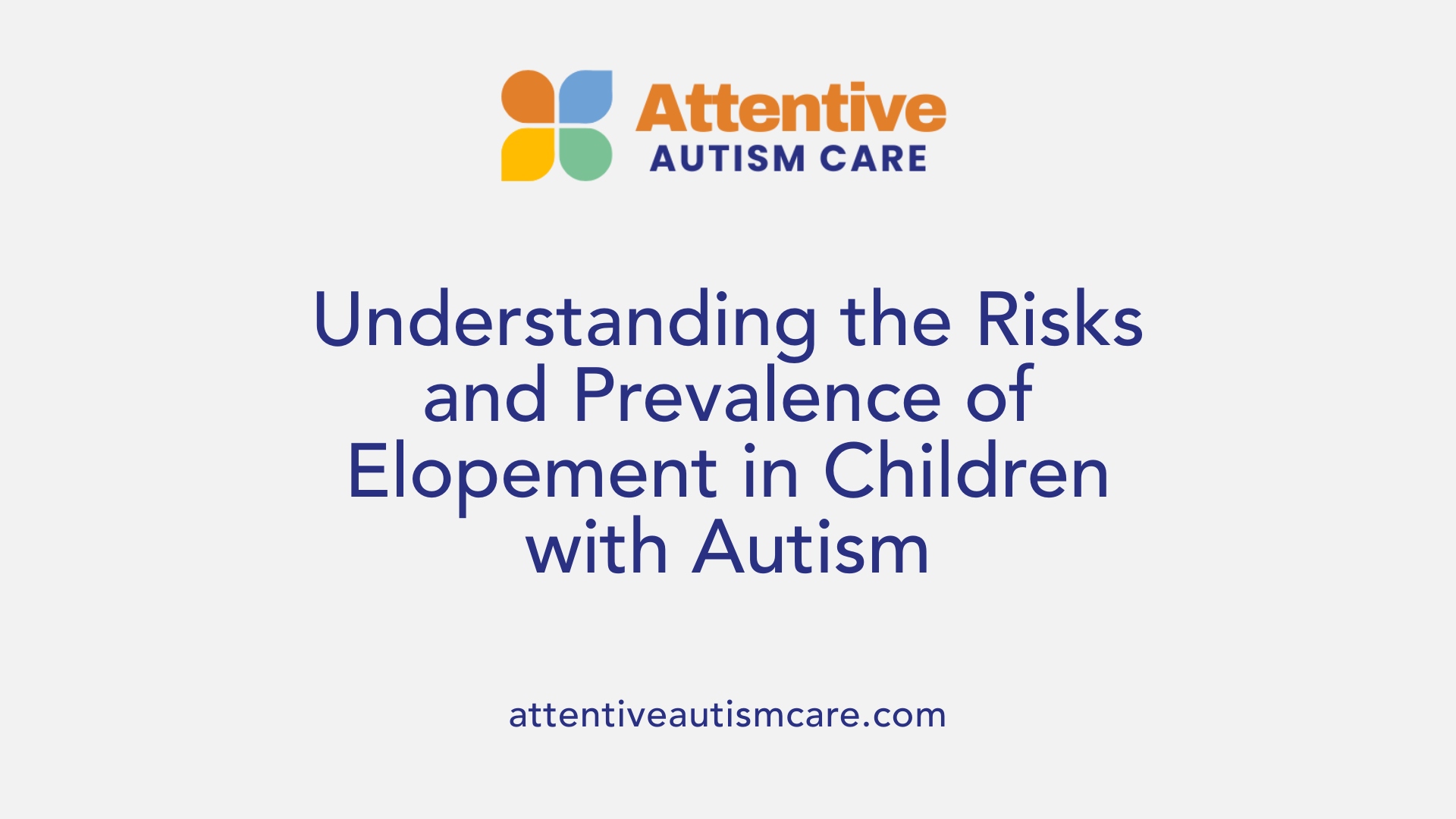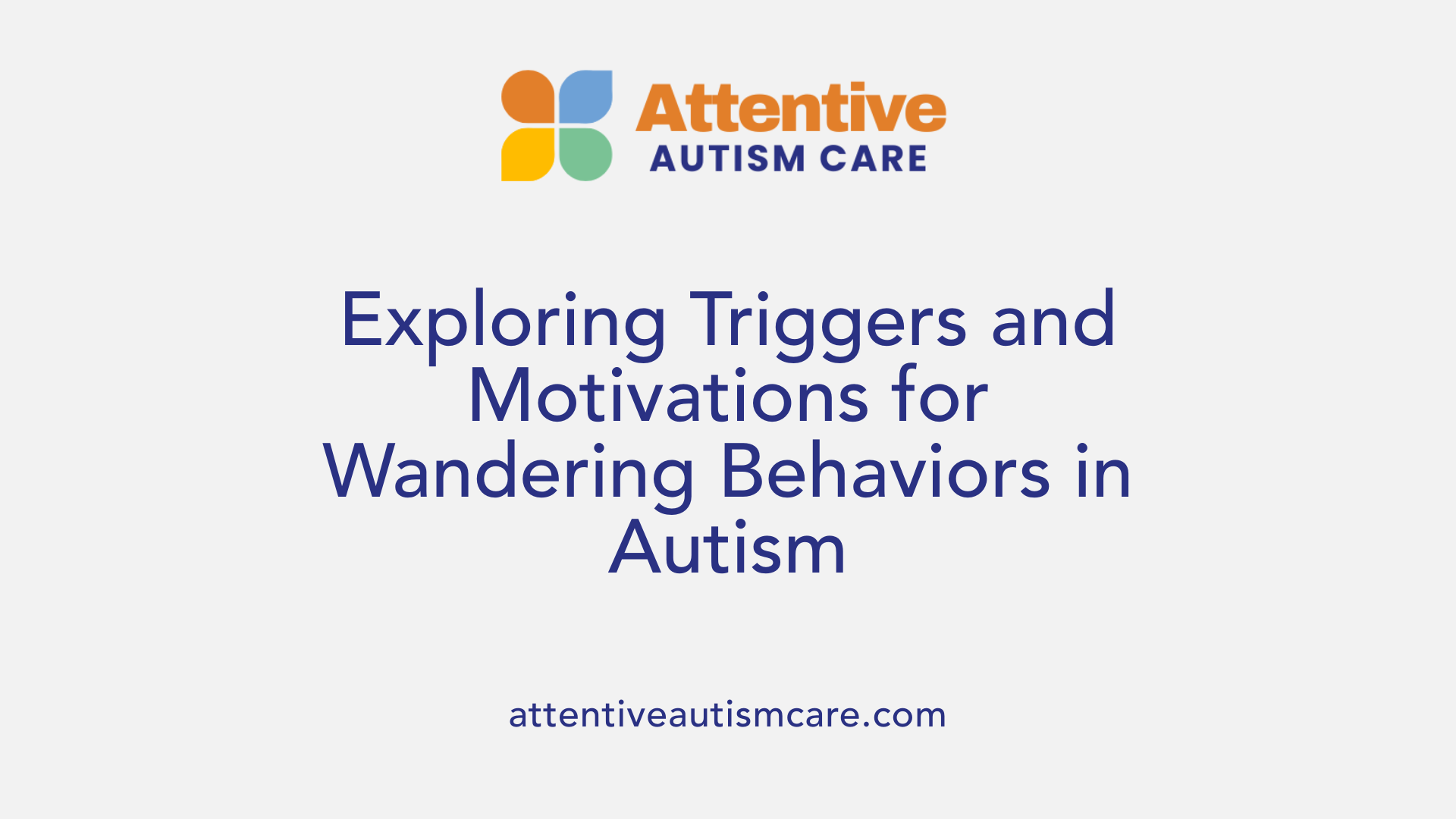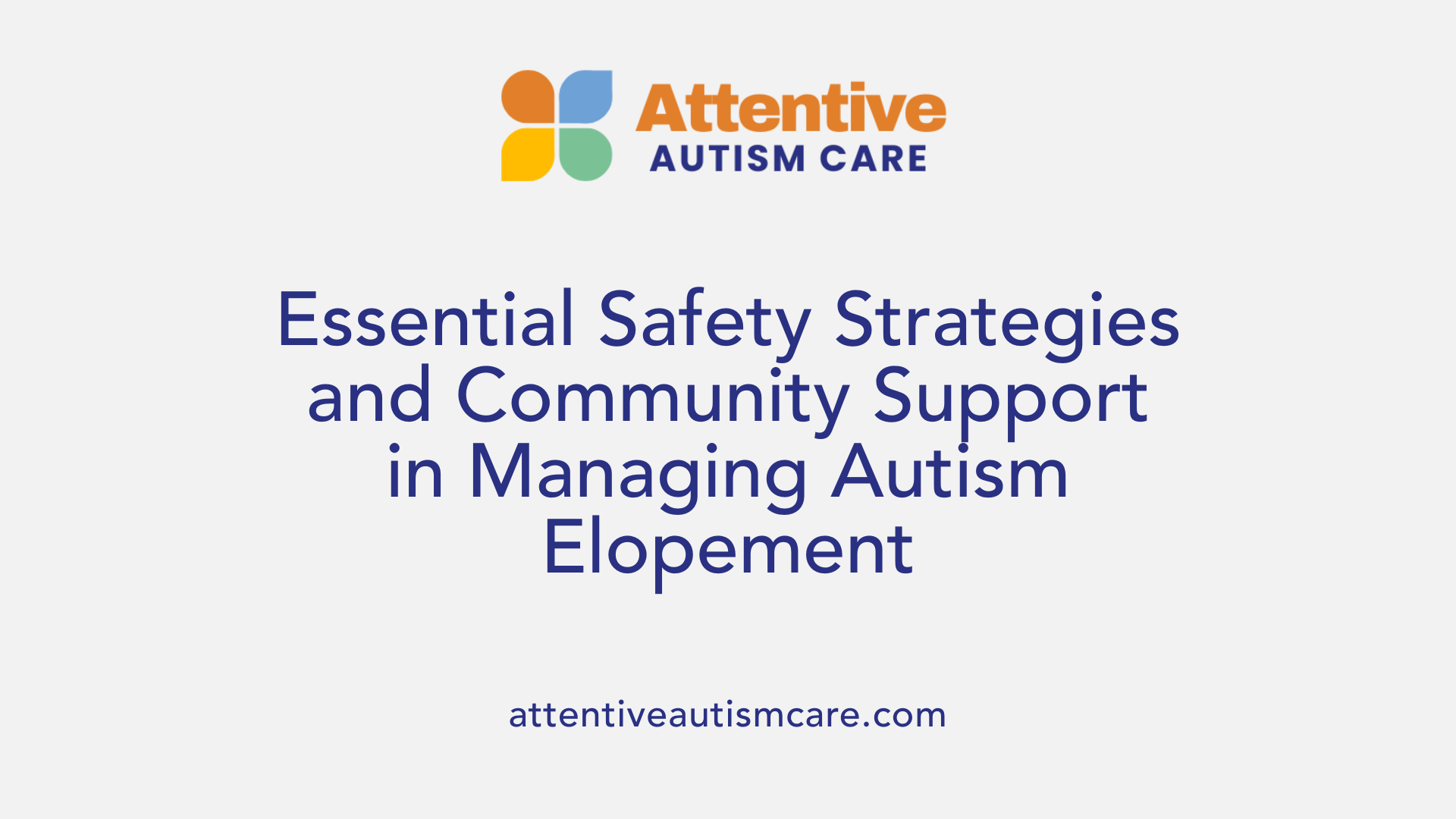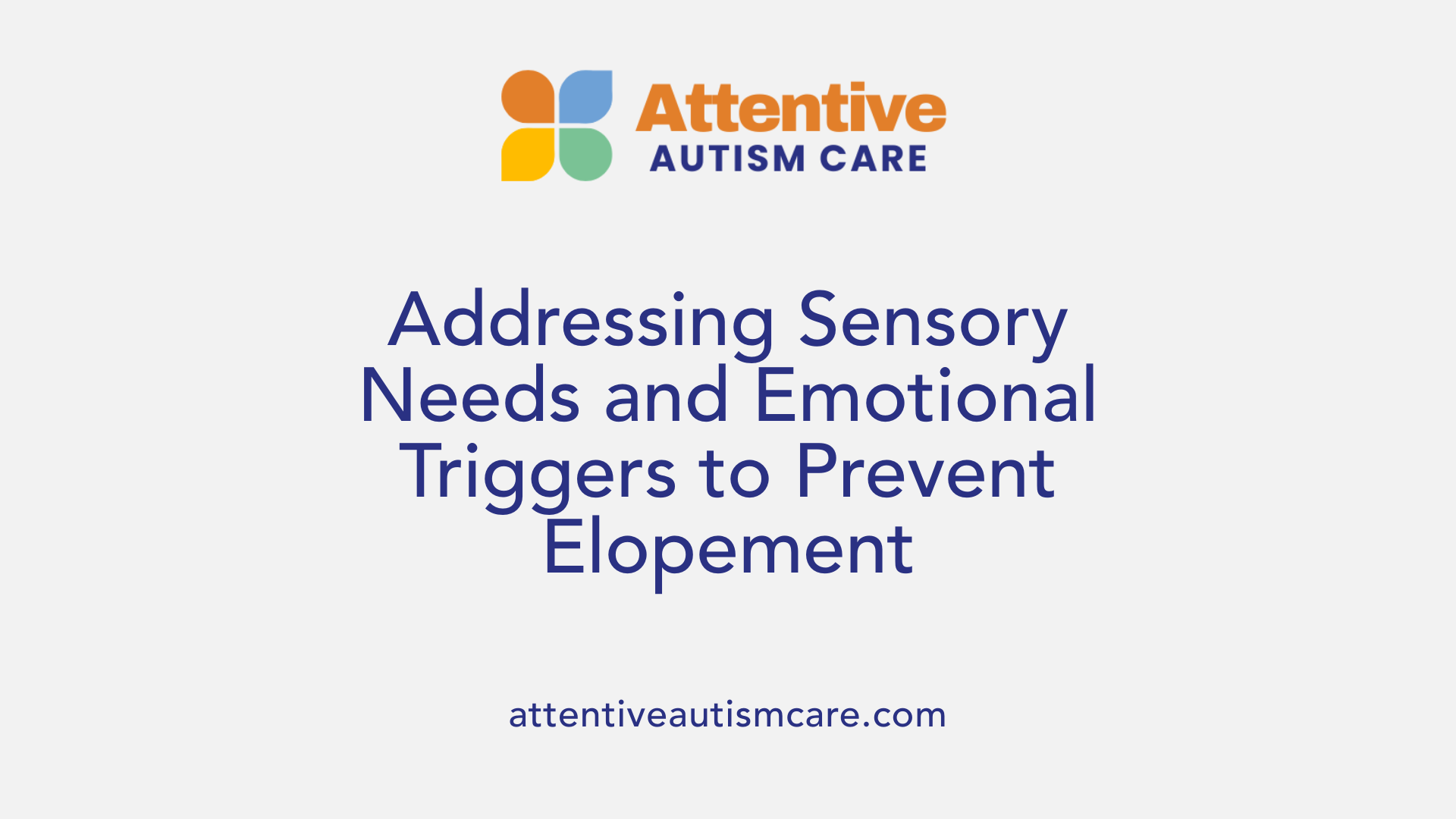Elopement and Autism
Understanding and Addressing the Challenges of Autism-Related Elopement

Introduction to Elopement in Autism
Elopement, also known as wandering, is a common and serious behavior among children with autism spectrum disorder (ASD). It involves children leaving a monitored or safe environment without permission or warning, often driven by various triggers. These behaviors pose significant safety risks, including drowning, traffic injuries, and exposure to hazardous situations. With nearly half of children with autism attempting to elope at some point, understanding the underlying causes, safety measures, and intervention strategies is essential for families, caregivers, and communities.
The Nature and Prevalence of Elopement in Autism

What percentage of children with autism are known to elope, and what are the risks involved?
Studies indicate that approximately 49% of children with autism are known to engage in elopement, also called wandering or bolting. This behavior involves running away from a monitored environment, often without warning and sometimes towards dangerous areas like roads, water, or unfamiliar places. More than half of these children go missing long enough for parents and caregivers to be seriously concerned. The risks involved are significant and can be life-threatening. Drowning is the leading cause of death associated with elopement, accounting for about 71% of fatalities, with children being 160 times more likely to drown than their neurotypical peers. Additionally, traffic injuries pose a substantial threat, with about 65% of wandering children being at risk of traffic-related accidents. The combination of these dangers highlights why managing elopement behaviors is crucial for the safety of children with autism. Experts recommend proactive safety strategies such as securing environments, utilizing GPS tracking, improving communication skills, and understanding individual triggers to help safeguard these children.
How can parents, teachers, and caregivers learn more about autism wandering behaviors and how to address them?
Parents and caregivers can increase their understanding of wandering behaviors through a variety of resources, training programs, and community support organizations focused on autism safety. Organizations like Autism Speaks and the National Autism Association offer educational materials, safety toolkits, and detailed guides on preventing wandering. Developing personalized safety plans involving environmental modifications—such as installing locks, alarms, and fencing—is vital. Learning about behavioral interventions like Applied Behavior Analysis (ABA) and functional communication training (FCT) helps teach children alternative ways to communicate their needs or escape triggers. Community awareness also plays a role; collaborating with neighbors, emergency services, and local authorities ensures a swift response if a child wanders. Regular caregiver training on recognizing early signs of exit-seeking behaviors, water safety, and emergency procedures enhances overall safety. Staying informed through credible sources, participating in support groups, and sharing safety plans with all involved parties form the backbone of effective wandering management.
What safety measures and intervention techniques are recommended for managing autism-related elopement?
Managing elopement requires a comprehensive approach combining environmental safety measures and behavioral interventions. Environmental modifications include installing locks on doors and windows, using alarms, adding fencing around the yard, and attaching wearable GPS devices or ID bracelets. Behaviorally, teaching safety skills—such as crossing streets safely, swimming, and recognizing dangerous situations—is critical. Functional Communication Training (FCT) helps children express their needs effectively, reducing the urge to elope. Caregivers should also develop emergency response plans, ensure constant supervision, and involve community resources and first responders. Practicing safety drills, creating visual aids and social stories, and involving the child in safety training can improve responsiveness. Implementing these strategies creates a layered safety net, combining physical barriers with behavioral skills, to lower the likelihood of wandering and improve immediate response if wandering occurs.
Are there resources or tools available to help with safety planning and emergency preparedness for children with autism prone to wandering?
Yes. Numerous organizations provide valuable tools for safety planning. Autism Speaks offers the Autism Safety Kit, which includes alarms, ID accessories, and safety tips tailored for children at risk of wandering. The Autism Society works with families to develop individual emergency plans, including creating detailed profiles, emergency contact forms, and training modules. Many communities have programs to notify local law enforcement and first responders about children with autism who may wander. Furthermore, wearable GPS tracking devices, alert systems, and identification tools such as wristbands or tattoos are widely available. Family emergency plans should include detailed location maps, contact lists, and routines for prompt search and rescue. Educational resources like social stories and visual supports teach children about safety rules and consequences, empowering them to help prevent elopement. These resources collectively help families prepare for emergencies and create reliable safety nets, reducing risks during wandering incidents.
What are effective strategies to prevent elopement in children with autism?
Preventing elopement involves a mix of environmental, behavioral, and educational strategies. Securing homes with locks, alarms, fence barriers, and window restrictors minimizes opportunities for wandering. Teaching safety skills—such as water safety, road crossing, and recognizing danger—is essential. This can be achieved through behavioral interventions like ABA and FCT, which teach children to seek help or alert caregivers. Developing a solid safety plan, including clear routines, emergency contacts, and response steps, is fundamental. Regular practice of safety drills helps children learn their roles during an escape or emergency. Community involvement is also crucial. Informing neighbors, local police, and emergency responders about the child's wandering risk ensures quick action in emergencies. Creating a safe outdoor environment, familiarizing children with safe places, and supervision during outings further reduce elopement probability. By combining environmental safety, skill development, and community support, families can significantly lower the risk of elopement.
How does elopement impact families and caregivers of children with autism?
Elopement dramatically affects families, often causing high stress levels, anxiety, and emotional distress. The constant worry about safety, especially near water or busy streets, can lead to sleep disturbances and social withdrawal. Many caregivers report feeling overwhelmed due to the unpredictable nature of wandering behaviors. The financial burden of safety devices, therapy, and additional supervision is also a concern. Parents often experience guilt or frustration when preventive measures fail, or incidents occur. The persistent fear of potential injury, drowning, or traffic accidents adds to the emotional toll. Moreover, managing wandering behaviors can limit family activities, reduce independence, and strain mental health and social relationships. Supporting families through accessible resources, support groups, counseling, and community awareness initiatives is vital. Providing tools and training empowers caregivers, reduces stress, and improves safety for children with autism.
What is known about the progression of elopement behaviors in children with autism?
Elopement behaviors can persist throughout adolescence and into adulthood, particularly in individuals with severe autism and limited communication skills. These behaviors are often goal-directed, such as escaping stressful situations, or seeking access to preferred objects or places. Research indicates that many children who elope continue to do so over years, with some studies showing that elopement attempts peak around age 5.4 years but remain a concern through later childhood and adulthood. Behavioral interventions like Functional Communication Training help reduce these behaviors by teaching alternative responses. Preventive measures, including environmental modifications, supervision, and safety training, remain essential over time. The ongoing risk underscores the importance of a lifelong safety plan, especially for those with ongoing behavioral and developmental challenges.
The Causes and Motivations Behind Elopement in Autism

Triggers for elopement
Children with autism often run away from safe environments due to specific triggers that set off elopement behaviors. These triggers can include sudden changes in routine or environment, sensory overload, or a desire to reach something the child finds appealing. External stimuli such as loud noises, bright lights, or crowded places can overwhelm children, prompting them to escape in search of relief or safety.
Reasons children with autism may run away
Many children elope driven by goals or needs that are hard to communicate. For example, a child might run away to access a favorite toy, food, or activity, or to get closer to a person they desire to see. Sometimes, they seek to escape stressful or unpleasant situations, such as overwhelming sensory input or social demands. Curiosity and the desire for fun or exploration also motivate wandering behavior, especially when their surroundings become too restrictive.
Role of sensory needs and environment
Sensory needs significantly influence elopement. Some children seek intense sensory experiences like water, movement, or tactile sensations, leading them toward environments like water bodies, busy streets, or noisy areas. Conversely, children overwhelmed by sensory stimuli might attempt to find quieter, less stimulating spaces, often outside safety boundaries. These sensory motivations are deeply personal, requiring caregivers to understand each child's sensory preferences and sensitivities.
Communication difficulties as a factor
Limited communication skills greatly contribute to elopement. Non-verbal children or those with restricted expressive language often cannot convey their discomfort, hunger, or needs. When they feel overwhelmed or distressed, they may run away in an effort to find relief or escape from an intolerable situation. This form of behavior is often a non-verbal way of signaling that they need help but lack the means to articulate it. Improving communication through functional communication training reduces such wandering incidents.
Impulsivity and understanding of danger
Impulsivity—a tendency to act quickly without considering consequences—plays a major role in elopement. Many children with autism act on immediate impulses, such as chasing a moving object or following a sound, without understanding the dangers involved. Their limited comprehension of risky environments, like busy roads or water hazards, increases their vulnerability. Children with lower cognitive and communication abilities are especially at risk, highlighting the need for structured safety education and constant supervision to prevent dangerous escapes.
The Underlying Causes of Elopement in Autism and Psychosocial Factors

What is known about the progression of elopement behaviors in children with autism?
Elopement behaviors in children with autism are complex and tend to persist over time. Research shows that nearly 50% of children with ASD attempt to wander at least once after age 4. These behaviors often continue into adolescence and adulthood, especially in children with more severe autism and noticeable communication or social challenges.
Elopement is frequently goal-oriented. Children may leave a safe environment to escape stressful situations, access preferred objects or activities, or find attention. Although some children may outgrow certain wandering episodes, many continue to elope due to persistent triggers and underlying needs.
Behavioral interventions such as functional communication training (FCT) and assessment are effective in understanding the reasons behind wandering. Safety measures, including constant supervision, environmental modifications, GPS tracking, and safety education, are critical for protecting children who continue to wander. Preventive efforts aim to reduce risk factors like drowning and traffic injuries, which are significant dangers associated with elopement.
Why do children with autism elope?
Children with autism often run away from safety for multiple reasons. Fear or anxiety might trigger escape responses, especially during overwhelming sensory experiences like noisy environments or bright lights.
Curiosity and a desire to explore new or interesting objects also motivate elopement. Many children seek to reach a favorite place, person, or item, such as water bodies, stores, or friends.
Changes in routine or environment can cause confusion or distress, prompting children to run away. Additionally, sensory overload, seeking sensory input, or fun can lead to wandering.
Communication difficulties further amplify elopement risks. Non-verbal children or those with limited expressive skills may use elopement as a non-verbal way to express discomfort or unmet needs when they cannot communicate verbally.
Impulsivity and limited safety awareness explain why many children are unable to recognize dangers like traffic or water hazards, intensifying their risk of injury.
How do sensory needs influence elopement behavior?
Sensory processing differences are a major factor in wandering among children with autism. Overwhelming sensory input, like loud sounds, bright lights, or textures, can cause children to seek relief or escape from uncomfortable stimuli.
Conversely, some children are sensory-seeking. They crave intense sensory experiences such as movement, tactile sensations, or water contact. This craving can lead them to wander toward water, noisy streets, or crowded areas.
Understanding individual sensory profiles helps caregivers create safe environments, including sensory-friendly zones and activities that fulfill these needs without risking safety.
What role do communication difficulties play in elopement?
Communication barriers make it challenging for children with autism to express their needs or discomfort, often resulting in wandering. Non-verbal children or those with limited speech may not communicate when they are upset, anxious, or overwhelmed.
This inability to articulate distress leads children to use elopement as a strategy to escape unpleasant conditions or to seek something they want.
Lack of understanding of dangers further hampers their safety. Children might leave a secure area because they do not comprehend hazards like traffic or water.
Implementing functional communication training (FCT) and teaching alternative ways to express needs can reduce elopement. Improving communication skills empowers children to share their feelings and needs safely.
How do impulsivity and understanding of danger contribute to elopement?
Impulsivity is a significant driver of wandering in children with autism. Many act on immediate urges without considering consequences. Their limited understanding of safety or danger—such as crossing streets without awareness—exposes them to serious risks.
Children with greater severity of autism and lower cognitive abilities are particularly prone to impulsive wandering. They might not recognize threats or remember safety instructions.
To address this, behavioral strategies focus on teaching safety awareness, self-regulation, and impulse control. Nevertheless, due to the impulsive nature and safety vulnerabilities, supervision and environmental safety measures like fences, alarms, and GPS trackers are essential.
Understanding the multifaceted reasons behind elopement helps caregivers develop comprehensive safety plans. These include recognizing individual triggers, teaching safety skills, and creating safe environments to mitigate risks and ensure the well-being of children with autism.
Safety Strategies, Emergency Response, and Community Involvement

What safety measures and intervention techniques are recommended for managing autism-related elopement?
Managing autism-related elopement requires a multipronged approach that emphasizes both prevention and preparedness. Environmental safety modifications are foundational; these include installing secure locks on doors and windows, adding fencing around yards, and using safety gates to limit accessible escape routes.
In addition to physical modifications, utilizing technology such as GPS tracking devices, wearable ID bracelets, and alarms can rapidly locate a child if they wander away. These tools are vital in reducing response times during emergencies. Creating and updating detailed safety plans is crucial. Such plans should be shared with all caregivers, educational staff, and local first responders to ensure coordinated responses.
Behavioral interventions play a key role. Techniques like Functional Communication Training (FCT) help teach children alternative ways to express needs or escape undesirable situations, decreasing the likelihood of elopement. Regular training for caregivers and community members—including neighbors and emergency personnel—helps increase their responsiveness and effectiveness.
Teaching children specific safety skills, such as recognizing danger, crossing streets safely, and knowing how to call for help, further mitigates risks. Overall, combining environmental safety, technology, behavioral strategies, and community awareness offers a comprehensive approach to managing and preventing elopement in children with autism.
Are there resources or tools available to help with safety planning and emergency preparedness for children with autism prone to wandering?
A variety of resources and tools are available to assist families and caregivers in safety planning for children prone to wandering. Autism Speaks provides several useful resources, including safety kits which contain alarms, identification tools, and visual aids designed for quick understanding and use. Their Wandering Emergency Plan offers a structured approach to preparing for potential incidents.
The Autism Safety Kit, including the Big Red Safety Box, offers practical safety devices such as alarms, ID tags, and reflective clothing, which increase a child's visibility and chances of being quickly found. Family emergency plans recommended by organizations include detailed emergency contact sheets, descriptions, and maps of familiar outdoor locations. These plans incorporate the addition of ICE (In Case of Emergency) contacts and protocols for communicating with first responders.
Community collaborations are encouraged, with first responder training and public awareness campaigns designed to improve response times and effectiveness. Local agencies often provide free or low-cost safety resources, and support groups can offer peer advice on best practices.
Healthcare providers and local authorities also facilitate the use of safety apps and GPS tracking, which can locate children within moments, thereby reducing the risk of serious injury or death.
What are effective strategies to prevent elopement in children with autism?
Prevention strategies encompass both environmental modifications and behavioral interventions. Securing the home is a priority: installing child-proof locks, alarms that sound when doors or windows are opened, and fencing around outdoor areas make an immediate difference.
Using GPS tracking devices and wearable ID bracelets helps locate children quickly if they wander. Behavioral techniques include teaching safety rules explicitly—such as how to cross streets or identify safe adults—and developing functional communication skills so children can express when they want to stay safe or need help.
Creating a comprehensive safety plan rooted in the Safety Planning Cycle—comprising needs assessment, skill-building, sharing information, and regular review—is vital. Building a secure community network involves neighbors, schools, and local authorities, so they are aware of the child's needs and can respond promptly.
Each of these measures, combined with caregiver vigilance and ongoing safety education, significantly reduces the likelihood of elopement and ensures swift action when it occurs.
How does elopement impact families and caregivers of children with autism?
Families and caregivers of children with autism face substantial emotional and practical challenges associated with elopement. The constant threat of a child wandering away creates high stress levels, anxiety, and sleep disturbances as caregivers remain vigilant around the clock.
The risk of injury or death, particularly from drowning or traffic accidents, intensifies family concerns, often limiting outdoor activities or social interactions. This can lead to social isolation, emotional exhaustion, and feelings of helplessness.
Financial burdens also increase, given the costs associated with safety devices, professional interventions, and emergency response measures. Many families report spending considerable time and resources on prevention, sometimes at the expense of their personal well-being.
Support networks, counseling, and respite care can provide relief, but access varies widely. Overall, elopement significantly adds to the emotional toll on families, emphasizing the need for accessible preventive tools and community support.
What is known about the progression of elopement behaviors in children with autism?
Elopement behaviors do not always resolve with age; in many cases, they persist into adolescence and adulthood, especially among children with more severe autism or those with additional challenges like lower cognitive or communication skills.
Research shows that elopement often remains goal-directed, with children seeking to reach specific places, objects, or people, or to escape stressful situations. While some children may diminish wandering as they age and develop better safety skills, many continue the behavior, maintaining high risk levels.
Behavioral interventions, including Functional Communication Training and social stories, can help reduce the frequency and urgency of elopement behaviors. However, ongoing supervision and safety measures remain essential.
Preventive strategies such as technological monitoring, environmental safety modifications, and community awareness should be sustained over time. Recognizing that elopement risk can persist into adulthood highlights the importance of lifelong safety planning for individuals with autism.
Knowing and Addressing Underlying Causes of Elopement in Autism

What role do sensory needs play in elopement behavior?
Sensory needs are a major influence behind many elopement incidents in children with autism. For some, over-stimulation from loud noises, bright lights, or busy environments becomes overwhelming, leading to a desire to escape to quieter or more predictable spaces. Others seek intense sensory input, such as tactile sensations from water, movement, or textures, which they cannot find comfortably within their usual environment. These sensory-seeking behaviors are often a form of self-regulation, helping children cope with overload or deficits in sensory processing.
Recognizing individual sensory profiles is essential for creating effective safety strategies. Providing safe sensory spaces and calming environments can reduce the child's urge to wander. Using sensory aids, organizing quiet zones, or offering preferred sensory activities in a controlled manner are preventive tools. Moreover, training caregivers and teachers on sensory needs helps in understanding when a child might be at risk of elopement. Implementing sensory-friendly strategies within the child's daily routine can lessen the motivation to escape, thereby reducing the risk of dangerous wandering.
What is known about the role of fight-or-flight response and impulsivity in elopement?
The fight-or-flight response is a natural survival mechanism activated when a child perceives danger, stress, or overwhelming stimuli. In children with autism, this response can inadvertently trigger elopement, as they may attempt to escape from situations they find threatening or intolerable. For example, loud environments, unfamiliar settings, or perceived threats can intensify feelings of distress, causing an impulsive run away.
Impulsivity further complicates this behavior. Many children with autism act on immediate urges without evaluating the consequences or understanding the dangers involved. Their limited communication skills can hinder them from expressing discomfort, frustration, or fear, making spontaneous fleeing more likely.
This combination dramatically increases the risk of accidents or injuries, particularly when children rush into traffic, water, or hazardous areas. It is crucial to teach self-regulation skills, understand each child's specific triggers, and maintain a safe, predictable environment. Using visual cues, social stories, and calming techniques can help children manage their fight-or-flight reactions and impulsive behaviors. Moreover, environmental modifications—such as securing dangerous areas and providing predictable routines—play a vital role in reducing these instinctive reactions. Caregivers trained to recognize early signs of distress can intervene before elopement occurs, enhancing safety measures and promoting calmness.
Conclusion and Path Forward
Elopement among children with autism presents complex safety, emotional, and logistical challenges that require proactive, multifaceted approaches. Understanding the behavioral motivations—such as curiosity, sensory needs, communication barriers, and impulsivity—enables caregivers and communities to implement targeted prevention strategies. Utilizing technological tools, environmental safety modifications, and behavioral interventions greatly reduce risks associated with wandering. Equally important is fostering community awareness and training first responders to respond effectively and compassionately. As research and resources continue to evolve, a collaborative effort among families, educators, healthcare providers, and community agencies can significantly improve safety and quality of life for children with autism and their families.
References
- Elopement Behavior in Kids with Autism
- Autism and Elopement: What You Need To Know About Wandering
- Occurrence and Family Impact of Elopement in Children With Autism ...
- Elopement – What Is It? - Lighthouse Autism Center
- ELOPEMENT PREVENTION CAREGIVERS - The Autism Project
- Autism Elopement: Causes, Risks, and Prevention
- Wandering - National Autism Association
- Autism, Wandering Elopement | Advocate Children's Hospital
- Wandering prevention | Autism Speaks




































































































